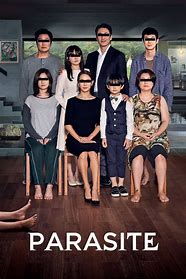Parasite, a story behind the story
The Oscar-winning film Parasite, directed by Bong Joon Ho, is regarded as one of the most critically acclaimed movies of all time. It features themes of class conflict, social inequality, and class hegemony. Using hyperbolic storytelling, the film explores the concept of class conflict and social inequality through the wealth gap. It is a perfect example of how modern society is characterized by class differences. The movie is able to provide an enjoyable and unsettling depiction of these issues through its use of subtle dialogue and brilliant metaphors. The movie leaves everyone struggling with the sudden changes in their lives. However, the use of exaggeration is crucial, as it highlighted a key aspect of social stratification. It also helps us keep thinking about what class means in our daily lives.
The film's poster is very important to us as it shows the various ways in which people are separated from one another. The colors of the bars on the individuals' eyes indicate their relationships with one another. This is the movie's first feature that shows the division between the poor and the rich. The three components of sociology are property, power, and prestige. The quantity of each determines which individuals fall under the social class hierarchy. Those belonging to the upper-middle, working poor, capitalist, and lower-middle are considered to be members of the social class hierarchy.
The concept of the social ladder is similar to the metaphor shown through stairs in Parasite. The Kims are impoverished and suffer from poor physical health due to their position in the lower socioeconomic class. They struggle to deal with the fumes from sterilization efforts and eat inexpensive food. During the monsoon season, their basement floods, and they often come in contact with sewage and waste. Their economic situation also affects their education. Ki-jung and Ki-Woo, who are both talented in their respective fields, cannot continue their studies. This means that their children do not have a chance of being better off.
The Kim family is not in all three categories. They are a poor family of four adults who live in a semi-basement. They lack resources and power to do anything they want. When the two main characters, Moon-gwang and Geun-sae, learned about their plan, they were unable to carry out their objectives. The Kims are severely disadvantaged due to how wealth equates to respect in a society where stability is lacking. Even if they could do something about it, they would find it impossible to do so. Being sociological criticized like this, leaves them at a disadvantage not only to themselves, but how society seems them.


Comments
Post a Comment